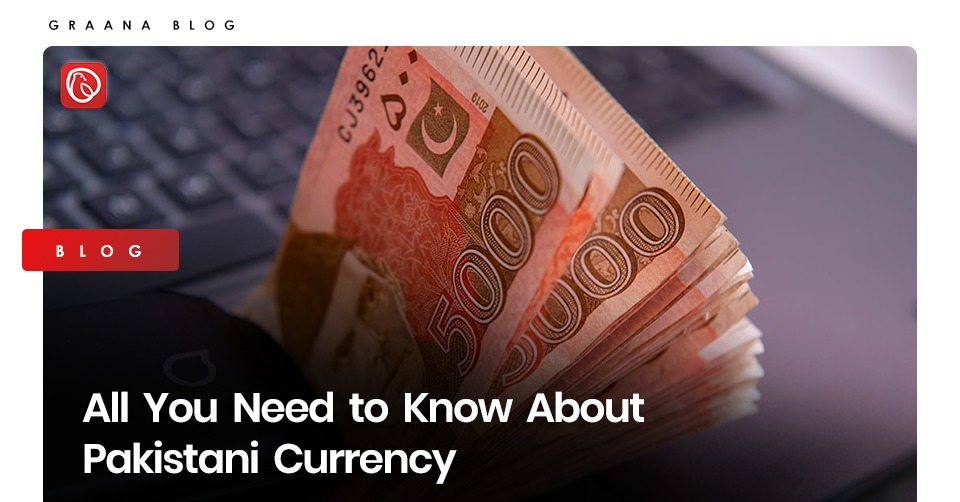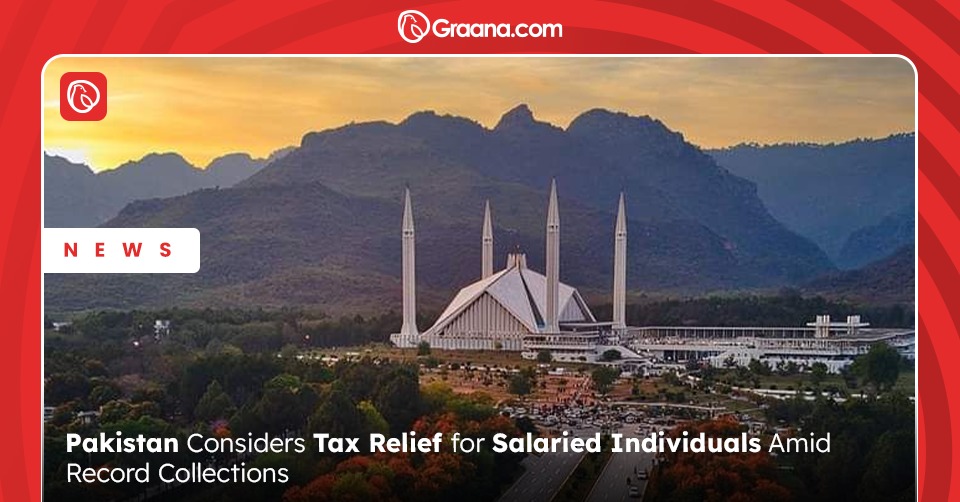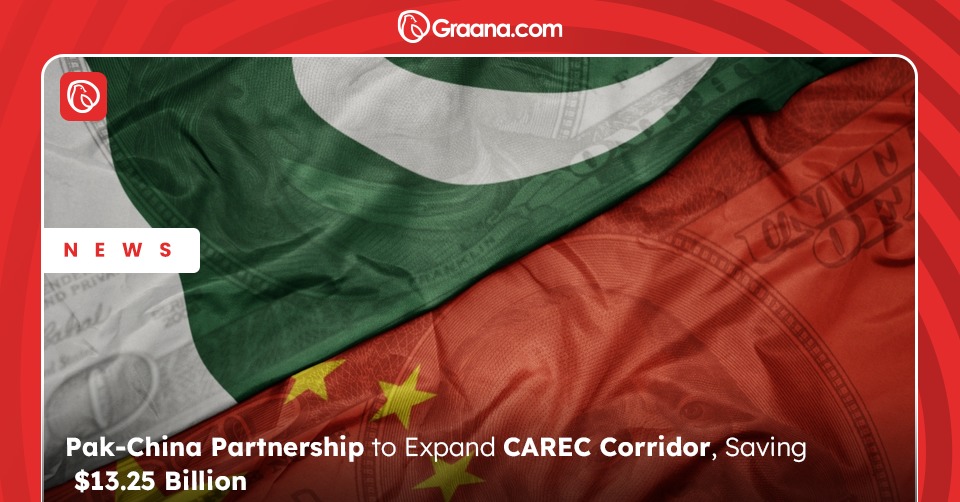Not many people are familiar with the origin and history of the currency that they use on a daily basis. For instance, what do the images printed on the notes denote, and what changes were made over time that led to the current banknotes in use today?
In this blog, Graana.com has covered everything you need to know about the Pakistani currency, including its history and some amazing facts.
History of Pakistani Currency Notes
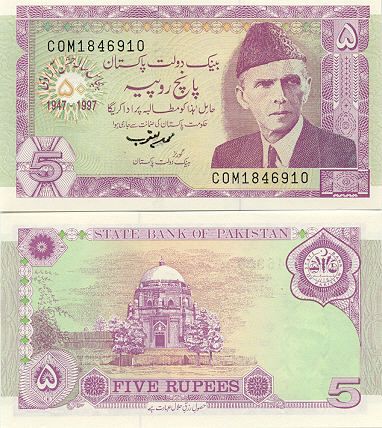
At the time of Pakistan’s independence in 1947, the subcontinent was using Indian currency, issued by the Reserve Bank of India. Being a newborn nation, it was not viable to instantly establish a central banking system.
Post-Independence
The Indian Rupee was the first paper money that Pakistan had, and it was printed with the words “Government of Pakistan” in English and “Hukumat-e-Pakistan” in Urdu on the white space designated for watermarks.
A day before India became independent, the Governor General of India approved to issue of money to the newly independent nation.
First Generation
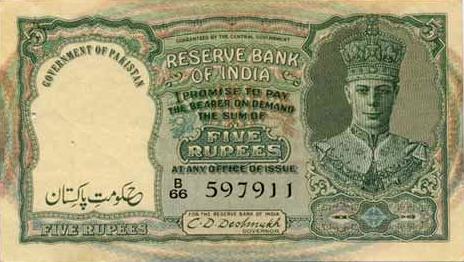
On 1st March 1949, the State Bank of Pakistan issued its first generation of currency notes, initially in Rs. 2 denomination, which was printed by Bradbury Wilkinson and Company.
These notes included features like a crescent moon watermark and security thread and were signed by Mr. Zahid Hussain, the first governor of SBP. They were printed in three languages: English, Urdu, and Bengali.
On 1st September 1951, this generation’s Rs. 5 and Rs. 10 notes, printed by Thomas De La Rue & Company, went on sale. The Rs. 100 note, produced by PSPC (Pakistan Security Printing Corporation) and Thomas De La Rue & Company, was introduced on September 15, 1953. A security thread and watermark were present on the notes of all three denominations.
Second Generation
Pakistani currencies’ security features have been continually improving. Ever more advanced security mechanisms have been added to different banknote generations to ensure that every succeeding series is more secure.
In 1956, it was decided to print Rs. 100 banknotes featuring a portrait of Quaid-e-Azam Muhammad Ali Jinnah, the Father of the Nation, together with a watermark featuring his image and the security thread. It was printed on 24th December 1957.
The usage of the portrait on this note became the standard for all SBP issues that followed. A Rs. 50 note featuring a promissory clause and the signatory’s designation was also issued on 12th June of the same year, which was later adopted for all other notes in this series.
Third Generation
SBP has constantly taken all necessary steps to ensure that its banknotes are handled with respect, without any personal or political agenda. To achieve this, all banknotes with political inscriptions were declared to be no longer legal tender on 8th June 1971, and all Rs. 100 and Rs. 500 notes were cancelled as well.
The Government of Pakistan demonetised the remaining notes in accordance with the aforementioned policy and, in an effort to mitigate any negative effects of East Pakistan’s separation, it also updated the colours of the second series from blue to dark blue. The Rs. 100 denomination was this series’s sole new design note.
Fourth Generation
The fourth generation series had both Urdu and English inscriptions so that any new series released by SBP represents the entire society. Rs. 1-notes began to be printed on 15th April 1975, and the government introduced a new version on 24th March, 1981.
The Rs. 5, Rs. 10, and Rs. 100 notes were issued on 12th June 1976, while the Rs. 50 note was presented on 29th December, 1977. In 1982, a line of Urdu text was added to the back of every denomination.
Fifth Generation
With the federal government’s consent, the SBP chose to issue new banknote designs with high-tech security measures to combat counterfeiting and boost the effectiveness of machine-based note processing.
With the help of a quality control system, these notes are created at PSPC, bringing Pakistani banknotes up to par with contemporary banknotes.
The first fifth-generation banknote, of Rs. 20, was introduced on 13th August, 2005, with new security measures. In November 2006, the Rs. 10, 100, 500, and 5000 banknotes were released. On 22nd March, 2008, a new colour scheme of orange-green-yellow was implemented for currency with a Rs. 20 denomination.
These new banknotes have identical security measures to the previous Rs. 20 note from 2005. New series of Rs. 5 and Rs. 50 banknotes were released on 8th July, 2008, currency of Pakistan name in short form is PKR.
Optical Variable Ink (OVI), a new security feature, was added to the Rs. 500 banknote on 25th January, 2010, making it simpler for the general public to identify the authenticity of the denomination.
History of Pakistani Coins
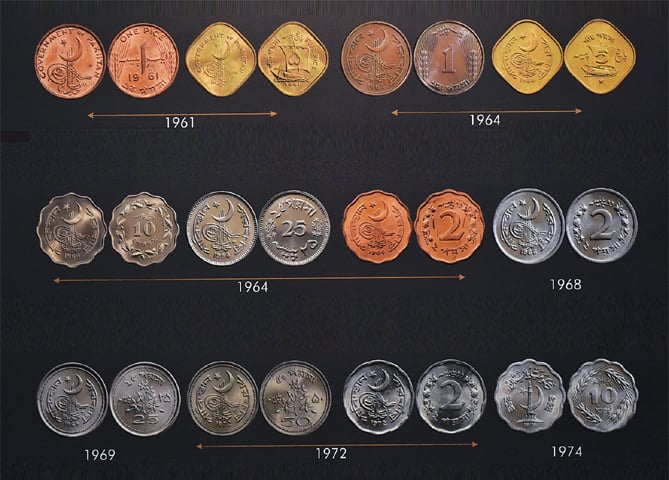
In the past, Pakistani currency also included coins of different values. Up until 1960, 1 Pakistani rupee included 16 ana, and each ana contained 4 paisa, making each rupee equal to 64 paisa. As a result, these were the following coins in use: 1 paisa, 2 paisa, 1 ana, 2 ana, 4 ana, 8 ana, and 1 rupee.
Following Pakistan’s adoption of the metric system in 1960, 1 Pakistani rupee included 100 paisa. There were 1, 2, 5, 10, 25, and 50 paisa coins available at the time. Prior to being decommissioned in the 1990s, the majority of these were still in use.
Depiction of the Backs of the Notes
Have you ever wondered what is printed on the back side of your money? Each note has an element of historical, national, or cultural significance printed on it, in addition to the watermarks and a variety of other printing requirements that help prevent forgery.
The following table gives a depiction of the back side of each of the currency notes that are currently in circulation.
| Value | Colour | Depiction of the Back Design |
| Rs. 10 | Green | Bab-ul-Khyber, the entrance to Khyber Pass |
| Rs. 20 | Brown/Orange Green | Mohenjo-Daro in Larkana District |
| Rs. 50 | Purple | K2, the second-highest mountain in the world |
| Rs. 100 | Red | Quaid-e-Azam Residency in Ziarat |
| Rs. 500 | Rich Deep Green | Badshahi Masjid in Lahore |
| Rs. 1000 | Dark Blue | Islamia College in Peshawar |
| Rs. 5000 | Mustard | Faisal Masjid in Islamabad |
Pakistan Currency Museum
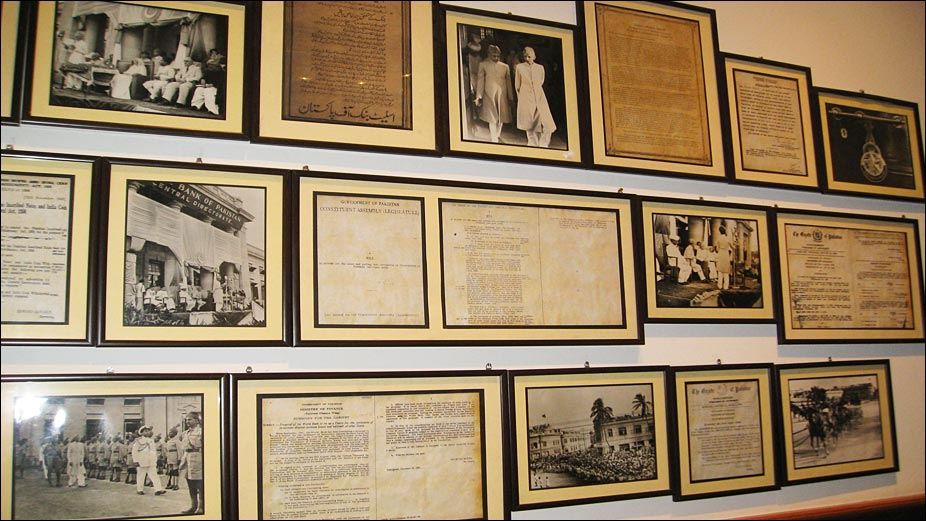
The museum is one of the oldest museums in Karachi. In one of its oldest offices in Karachi, close to its head office, the State Bank of Pakistan has established the nation’s first currency museum for anyone who is interested in learning more about the history of the Pakistani rupee.
The museum, which is situated on I. I. Chundrigar Road, is home to a wealth of information. Old coins and banknotes are on display. There are six galleries in the museum:
- Art Gallery
- Coins Gallery (I & II)
- Currency Gallery
- History of State Bank of Pakistan
- SBP Governors
- Stamp Gallery
The museum is open from Monday through Saturday, from 9:30 am to 5:00 pm.
5 Interesting Facts About the Pakistani Currency
Here are some fun facts about the Pakistani rupee.
Fact 1: The origin of the word ‘Rupee’ is Sanskrit.
The Sanskrit term “rupyakam”, which means “coin of silver”, is the origin of the English word “rupee”.
It is believed that a version of the ‘rupyakam’ was also in use during the middle of the third century BCE, even though the rupee did not exist until the 1500s.
Rupees are also called “rupaya” or “rupaye” by Pakistanis today.
Fact 2: The first coin with the name ‘rupee’ was introduced by Sher Shah in the 1500s.
The Mughal empire dominated the area long before Pakistan or India became independent countries, even before British colonisation. During his reign from 1540 to 1545, the Afghan ruler Sher Shah Suri established the rupee.
Not only Pakistan and India, but also Indonesia, the Maldives, Mauritius, Nepal, Seychelles, and Sri Lanka currently use the rupee as their official currency.
Fact 3: Pakistani rupees were first issued by India.
After the partition, Pakistan’s currency was initially issued by the Reserve Bank of India. Although India printed these notes, the mint inscribed “Government of Pakistan” on the banknotes. Later, the State Bank of Pakistan gained control of the creation, distribution, and printing of rupee banknotes.
Fact 4: Early versions of Pakistan’s currency included both Urdu and Bengali text.
Pakistan was divided into West Pakistan and East Pakistan after the partition. This meant that Bengali and Urdu were the two primary languages spoken in the nation.
Pakistan made accommodations by creating bilingual banknotes. However, Pakistan removed Bengali off its banknotes after East Pakistan separated to form Bangladesh in 1971.
Fact 5: Special “Hajj notes” were printed in Pakistan until 1978.
The number of Pakistani Muslims travelling to Saudi Arabia for Hajj increased dramatically in the 1950s.
As a result, the State Bank of Pakistan released special “Hajj notes”, which served as traveller’s checks, to make currency exchange simpler. These notes were in circulation until 1978; now they are now sought-after collectibles.
For more informative blogs, visit Graana Blog.
